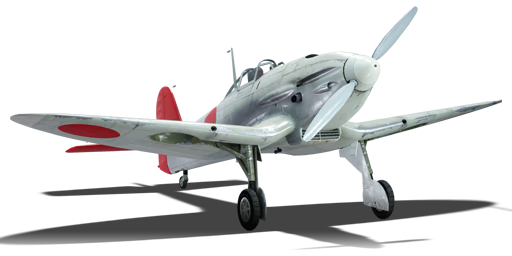



The A7He1 was the Japanese Navy's designation and purchase of the German He 112 B-0 to strengthen the IJNAS in China. The He 112 was a surplus model that Germany had discarded in favour of the Bf 109 and sold to other nations. The Japanese compared the A7He1 with their own A5M fighter, which was their best option at the time. The A6M, a more advanced fighter, was still under development. The A7He1 had superior guns and speed than the A5M4, but it lacked agility and climb performance. It also did not suit the Navy's aerial combat doctrine. The Japanese cancelled the order for more A7He1s and used them only for research purposes, studying their features, engine and equipment.
It was introduced in Update 1.37. It provides an interesting yet different playstyle to the Japanese tree. The main advantages of this plane are speed and firepower. It can reach a maximum speed of 690 km/h, which is very fast for its rank. However, it has a mediocre climb rate, and it is not very manoeuvrable or responsive. The best feature of this plane is its armament, which consists of two 20 mm cannons and two fast-firing 7.92 mm machine guns.
flaps
flaps
flaps
brake
| Belt | Belt filling | Armor penetration (mm) at a distance: | |||||
|---|---|---|---|---|---|---|---|
| 10 m | 100 m | 500 m | 1000 m | 1500 m | 2000 m | ||
| IT/IT/APHE | 19 | 18 | 15 | 10 | 4 | 4 | |
| IT/FI-T/FI-T/APHE | 19 | 18 | 15 | 10 | 4 | 4 | |
| FI-T/FI-T/AP-I/APHE/IT | 25 | 24 | 18 | 10 | 1 | 1 | |
| IT/IT/FI-T/FI-T | 10 | 10 | 5 | 2 | 1 | 1 | |
| APHE | 19 | 18 | 15 | 10 | 4 | 4 | |
| Belt | Belt filling | Armor penetration (mm) at a distance: | |||||
|---|---|---|---|---|---|---|---|
| 10 m | 100 m | 500 m | 1000 m | 1500 m | 2000 m | ||
| AP-T/AP-I/AI | 9 | 8 | 6 | 3 | 0 | 0 | |
| AP-T/AP/AI/AP-I | 13 | 12 | 7 | 3 | 2 | 0 | |
| AP-T | 9 | 8 | 6 | 3 | 0 | 0 | |
| AI/AP/AP/AP/AI | 13 | 12 | 7 | 3 | 2 | 0 | |







 2 x (30 / 60 / 120) %
2 x (30 / 60 / 120) % 
 2 x 112 %
2 x 112 % 

Flight performance | |
|---|---|
Survivability |
|---|
Weaponry |
|---|